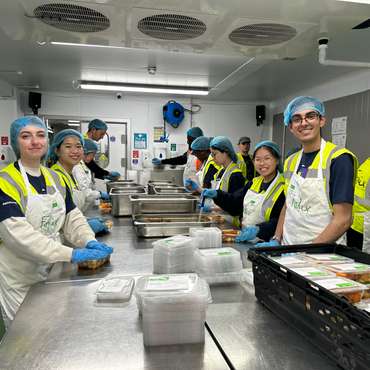Joan Steinberg
Global Head of Community Affairs and President of the Morgan Stanley Foundation

Many people are eager to offer their time to nonprofits and other organisations, but worry about how to get started, whether they will have the time and whether they have something valuable to offer. As the leader of organised volunteer efforts at Morgan Stanley, I often find myself saying, “Yes, you can - and here’s how!”
However enthusiastic people are, they may wonder what skills and value they offer. Or, they’re unsure which organisation to approach, or how much of a commitment they need to make. I always tell people not to hesitate. It’s true that you may be a better match for some organisations than others, but just about everyone has something of value to offer, and the old adage is true: you truly will receive far more than you give. Here are some ways to get involved:
1. Zero in on what you’re passionate about. Do you want to help children, for instance, or senior citizens? Do you care deeply about literacy or education, or about helping feed or clothe people in need? If a particular cause is one you yourself care about, chances are you'll put a lot more into it and get a lot more out of it. Your commitment is also likely to be more long-term.
2. Don’t sell yourself short. Everybody has skills worth sharing. The idea that some folks are more “qualified” or you need special skills is simply a myth. Consider, for example, organisations that work with children. For many, the one thing they require the most is an adult who’s present and caring. You don’t have to hold an advanced degree or have certain professional credentials (though, of course, it’s great if you do). You just need to show up - and step up.

3. Choose your organisation with care. Engagement is like dating, you are not going to like all charities equally, so take the time to find a good fit for you. Are you more like Monica than Phoebe from Friends? If you are a Monica, look for organisations that already have volunteers.
Check their sites and social media postings to see how they engage volunteers and the kind of work they do. Nonprofits that regularly use volunteers are more likely to be organised and efficient with your time. Either way, remember that the charity is driving a social mission, so look for opportunities where you can help them deliver that mission. Also remember: It’s not their job to make magical memories for you as a volunteer.
4. Try dipping in more than a toe. There’s nothing wrong with sitting at a registration desk, painting a mural or stuffing envelopes, but how about moving a little beyond your comfort zone and raising the bar. Sign on to the committee that’s planning the event, serve as a project leader, or consider lending your ‘on the job’ skills to their work.
5. On the flip side: Be realistic about your calendar. If you’re juggling a demanding job with responsibilities like caring for parents or children, your time may be limited. Why not write a cheque (or two) or provide some short-term strategic advice to an organisation until your circumstances change and you’re in a better position to contribute more regular hours?
6. Don’t shy away from fundraising: Many people are uncomfortable with the idea of asking other people for money, but for the nonprofit sector this is the lifeblood of their organisation. Simply put: no money, no mission. You don’t have to have rich friends to be a fundraising volunteer. Think about other skills: event planning, database management, communications, marketing. These are all key elements of a nonprofit’s fundraising efforts.
7. Join a board, but not just any board. Serving on a board is a terrific way to share your skills and passion in a way that really drives results. But even more than in basic volunteering, fit really matters. Take the time to meet with the board chair and senior staff person. Make sure you feel comfortable with them and the culture of the board. Think through how hands-on you want to be. Does this board really govern the organisation, or does the role seem more focused on fundraising? How many board committees and meetings are there? And remember that board members have a fiduciary responsibility as well. Regardless of the give/get requirement, you should be willing to donate an amount that hurts just a little bit if you are going to serve on the board.
8. Leave when it’s time. You’re not always going to love every task you’re conscripted to do. While a certain amount of dissatisfaction is okay, the psychic rewards must outweigh your complaints. At a certain point, it’s acceptable to feel that you’ve given all you’ve got to a particular organisation and that you want to move on to another. It’s perfectly okay to break up with your nonprofit.